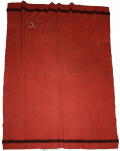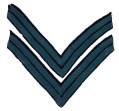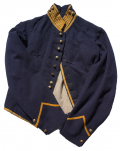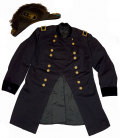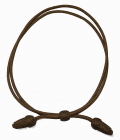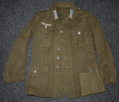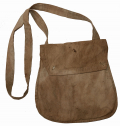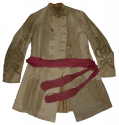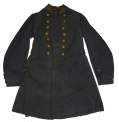site search
online catalog
Uniforms & Cloth
Showing 101 to 120 out of 216
CIVIL WAR BUMMER OR FORAGE CAP WITH NINTH CORPS BADGE
This is an excellent example of an original Civil War Union army regulation Model 1858 Forage Cap with a Ninth Corps badge on top, displaying the cross cannon and fouled anchor reflecting the origins… (1052-143). Learn More »
$4,000.00
Originally $4,500.00
CIVIL FORAGE CAP BY MURPHY AND GRISWOLD WITH 14th CORPS BADGE
Thomas Murphy, William Griswold & Company were hatters on 19th Street in New York City and had major contracts for caps and hats with the U.S. government from 1862 to 1865, with the firm changing… (1052-227). Learn More »
$3,700.00
Originally $4,250.00
ON HOLD
CIVIL WAR COMMERCIAL FORAGE CAP WITH MAINE BUTTONS AND ASSOCIATED INSIGNIA
Commercial caps were simply those purchased privately rather the issued by the government. They might more or less closely follow contract patterns with the purchaser able to suit his taste and… (1052-139). Learn More »
$4,000.00
Originally $4,500.00
IDENTIFIED ISSUE RED BLANKET OF THEODORE P. BOWKER 13th MASSACHUSETTS - DIED OF WOUNDS AT ANTIETAM!
This is a rare, early-war, identified Massachusetts issue red blanket carried by a soldier in the 13th Massachusetts who was wounded at Antietam on Sept. 17, 1862, and died of those wounds at a U.S.… (490-7138). Learn More »
$6,500.00
Originally $7,500.00
EXCELLENT PAIR OF CIVIL WAR FEDERAL INFANTRY REGULATION CORPORAL CHEVRONS/STRIPES
Union infantry companies fielded eight corporals. Along with the sergeants they might be charged with supervising squads or fatigue details, but in battle were posted in the front rank of the line of… (490-7163). Learn More »
UNION CAVALRY SHELL JACKET
The m1858 Mounted Services Jacket - trimmed in yellow - was ubiquitous among Federal Cavalry Troopers during the Civil War and into the West as a standard issue item. One of the war’s most… (2024-1844). Learn More »
$1,895.00
ON HOLD
MINT IDENTIFIED BREVET BRIGADIER GENERAL’S FROCK COAT AND CHAPEAU OF ALONZO ALDEN
This sets consists of Brevet Brigadier General Alonzo Alden’s mint condition brigadier general’s frock coat with shoulder straps and his full dress “light French chapeau,” allowed for officers… (1179-156). Learn More »
OFFICER’S GOLD TONE HAT CORD, ID’D TO COL. WILLIAMS, 9TH PA. CAVALRY
woven gold bullion cord, adjuster slide, and acorns. All in very fine condition. This has a verbal identification to Colonel Edward Williams, 9th Pennsylvania Cavalry. Author/historian Randy… (1256-108). Learn More »
5th NEW YORK NATIONAL GUARD COMPANY E FLANK MARKER
This very attractive blue silk marker with gold fringe and embroidered unit designation comes with a 1995 letter from flag authority Howard Madaus, a 2004 treatment report by Textile Preservation… (1179-014). Learn More »
WWII JAPANESE LEG WRAPS (PUTTEES)
Wraps and ties do not look to haven been shortened and there is a good amount of use war to them. There is a good bit of fraying on the edges of the wraps and the end of the ties. There is a white tag… (1235-258). Learn More »
VETERAN BRING BACK GERMAN "AFRIKA CORPS" TUNIC
This enlistedman's open-collared field blouse is the style developed in 1940 in anticipation of deployment of German forces to North Africa under Irwin Rommel. This jacket of mid-brown canvas/cotton… (1235-453). Learn More »
$3,200.00
Originally $3,500.00
EXCELLENT CONDITION UNION ARTILLERY SHELL JACKET
Standard issue dark blue wool shell jacket with red piping on collar and cuffs with red trim down the front and along the edges. Jacket has 12 General Service eagle buttons down the front with two… (1179-160). Learn More »
$2,750.00
ON HOLD
WORLD CLASS IDENTIFIED WOUNDED IN ACTION CIVIL WAR NORTH CAROLINA SOLDIER’S JACKET WITH BULLET HOLE FROM HIS WOUND AT THE WILDERNESS!
Formerly in the collections of the Texas Civil War Museum this world-class Confederate infantryman’s jacket worn by William B. Royal came directly out of the family in 2002, having been previously… (814-69). Learn More »
MASSACHUSETTS HAVERSACK
These smaller white canvas haversacks fastening with two bone buttons usually show up marked with an ink stamp as “inspected and accepted” by Massachusetts. This one was most likely so marked as… (2024-1382). Learn More »
WWII GERMAN WINTER MITTENS
Mittens show little age and use wear. The string to hang them around your neck is still attached. The markings are on the white side and are a little blurry. The insides are feldrgrau [green grey]… (1235-152). Learn More »
CONFEDERATE CAVALRY CAPTAIN’S FROCK COAT OF CAPT. EDWARD BIRD, “EFFINGHAM HUSSARS,” 2nd BATTALION AND 5th REGIMENT GEORGIA CAVALRY
This rare, identified, Confederate cavalry captain’s frock coat belonged to an officer who served from 1861 though 1865, rising from Captain to Colonel, with extensive action especially in… (1179-232). Learn More »
IDENTIFIED CONFEDERATE CAPTAIN’S FROCK COAT OF CAPTAIN PHARES WALDO SHEARER, 45th MISSISSIPPI, WITH 28-PAGE REMINSCENCES AND VETERAN’S BADGE- HE EXCHANGED SALUTES WITH THE WOUNDED JOHN BELL HOOD AT CHICKAMAUGA
This coat came directly out of the family along with a reunion badge and type-written copy of the officer’s 1906 reminiscences. The coat was formerly in the collection of Steve Mullinax, is… (1179-179). Learn More »
CIVIL WAR-INDIAN WAR FORAGE CAP VISOR
This is a well preserved leather visor from a forage cap recovered at Fort Pembina, ND, where it was preserved in remarkable condition by wet, anaerobic soil conditions. This is typical of the simple… (1052-480). Learn More »
CIVIL WAR-INDIAN WAR FORAGE CAP VISOR
This is a well preserved leather visor from a forage cap recovered at Fort Pembina, ND, where it was preserved in remarkable condition by wet, anaerobic soil conditions. This is typical of the simple… (1052-483). Learn More »
FIRST WORLD WAR US M1917 HELMET WITH 78TH DIVISION INSIGNIA
This is a US made M1917 steel helmet used by a member of the 78th Infantry Division. Nearly identical to the British army helmet, the M1917 and later the M1917A1 were used up to the Second World War,… (490-6909). Learn More »
Showing 101 to 120 out of 216
Most Popular
Historical Firearms Stolen From The National Civil War Museum In Harrisburg, Pa »
Theft From Gravesite Of Gen. John Reynolds »
Selection Of Unframed Prints By Don Troiani »
Fine Condition Brass Infantry Bugle Insignia »
featured item
ARMED CONFEDERATE LIEUTENANT COLONEL
This uncased eighth-plate tintype is a very clear studio view of a Confederate lieutenant colonel wear frock coat, narrow brim hat, gauntlets and tall boots. He has tilted his hat slightly to one side and wears a sort of tight-lipped smile. His… (1138-2029). Learn More »
site search
Upcoming Events
The shop is currently closed so that we may conduct our annual inventory. We are available by phone… Learn More »






